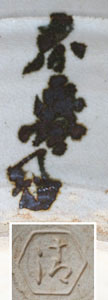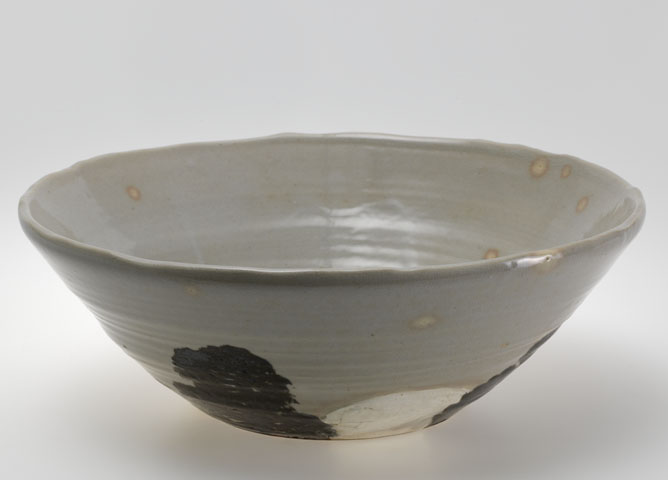Kyôyaki
Kashibachi, cake bowl – Mangetsu, Full moonSigned: Shunkyo
Seals: Kiyo
Technique: Kyôyaki, grey earthenware from Kyoto with a white and dark brown, tetsu-e, iron oxide decoration under translucent grey crackled glaze. Ø 24 x 8,5
Box: signed by both potter and painter
Condition: very good
Shunkyo was born in Shiga prefecture. He studied painting with Nomura Bunkyo (1854-1911), but after Bunkyo moved to Tokyo in 1885, Shunkyo became a pupil of Mori Kansai (1814-1894). Together with Tsuji Kakô (1870-1931) he worked at Takashimaya department store where they created designs for export textiles. He studied photography and yoga (western-style oil painting). After 1900 he became one of the most successful Nihonga artists in Kyoto and his juku (private school) was as popular as that of Takeuchi Seihô (1864-1942). After his return to Shiga, his house and studio near Lake Biwa were located next-door to the Zezeyaki kiln, which he helped revive.
Reference:
Kyôto 1982
Shiga 1985
Shiga 2000
Berry & Morioka ‘99 pp. 126-127
Conant pp. 330-331
Roberts p. 196
Rokubei V, the second son of Kiyomizu Rokubei IV, studied Shijô painting with Kôno Barei (1844-1895) and also at the Kyoto Prefectural School of Painting. After his graduation he studied ceramic techniques with his father and glazing techniques at the Kyoto Municipal Ceramic Laboratory. He worked on the research of new glazing techniques and western designs. When Rokubei IV retired in 1913, he inherited the title and became Rokubei V. He exhibited at the Nôten, the Design and Applied Artworks Exhibition sponsored by the Ministry of Agriculture and Commerce, and at the Teiten, the Imperial Art Academy Exhibition. He also became a member of the Imperial Art Academy and played an important role as a leading figure of the craft world. In 1945 he retired.
Reference:
Kyoto ‘03, ’Sekka’ p. 326 ff.
Price: ON REQUEST

